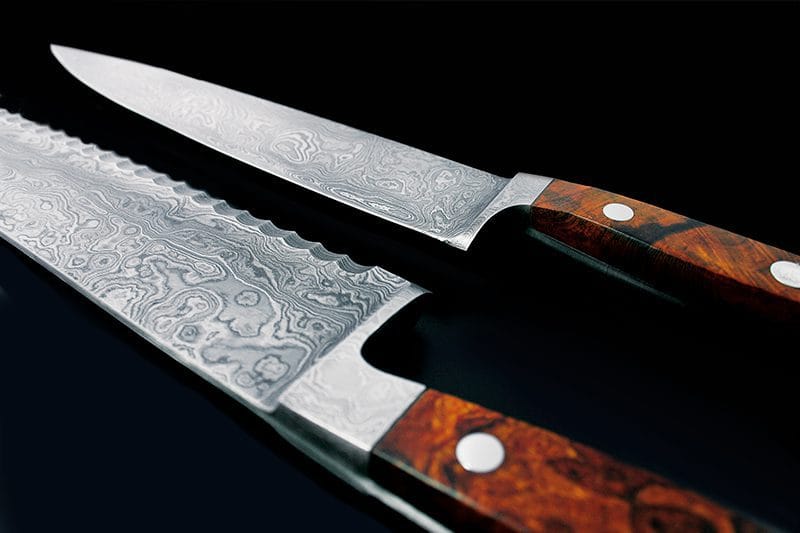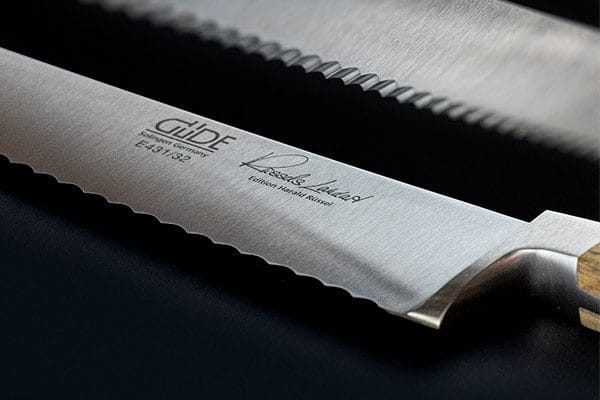Bestandteile eines Messers
An das Klingenmaterial von Messern sind eine Fülle von Anforderungen zu stellen, die sich zum Teil widersprechen. Also gilt es, ein Optimum zwischen den verschiedenen Anforderungen zu realisieren. So soll ein Messerstahl hart sein, jedoch nicht zu hart, da er ansonsten brechen würde. Er soll aber auch nicht zu weich sein, da das Messer sonst durch Abnutzung zu schnell stumpf werden würde. Daher sind die Messer von GÜDE aus einem Chrom- Molybdän-Vanadium-Messerstahl gefertigt, der eine optimale Härte von ca. 57-58 HRc (Rockwell) hat.
Ausnahmen sind Messer aus Carbon- oder Damaststahl. Carbonstahl enthält mehr Kohlenstoff, kann dadurch höhere Härtewerte aufweisen, ist aber anfälliger für Rost. Damaststahl besteht aus verschiedenen Schichten eines harten und eines weicheren Stahls und vereint damit die Vorteile, aber auch die Nachteile, denn er ist nicht rostfrei.
Holz ist ein natürliches Material. Seine Farbe und Maserung machen aus einem Messer einen echten Hingucker. Aber auch beim Greifen eines Messers zeigt Holz seine angenehme Seite, fühlt es sich doch warm und handschmeichelnd an. Griffe aus Holz sind jedoch nicht spülmaschinengeeignet, im Gegenteil zu Griffen aus Kunststoff. Kunststoffgriffe von GÜDE sind aus Hostaform und erfüllen die Anforderungen der Gastronomie. Sie sind pflegeleicht und spülmaschinenfest.
Schmieden im Gesenk sorgt für eine hohe Materialfestigkeit auch bei dynamischen Beanspruchungen. Beim Gesenkschmieden wird der gesamte Schmiede-Rohling erwärmt und verformt.
Im Gegensatz dazu wird beim Stauchschmieden nur ein kleiner, meist der mittlere Teil des Bandstahls erwärmt und dann verformt. Diese Methode wird meist aus fertigungsökonomischen Gründen angewendet, das erzielbare Formengut ist sehr begrenzt.
Beim Gesenkschmieden ist die Formensprache frei von der Klingenspitze bis zum Griffende. Eine Formensprache wie bei SYNCHROS oder THE KNIFE. ist nur im Gesennkschmiede-Verfahren möglich. Deshalb bleibt GÜDE dieser bewährten Technologie treu.
Auch ein harter Stahl, wie z.B. der GÜDE Messerstahl, kann, wenn er sehr dünn ausgeschliffen wird, sehr flexibel sein. Eine flexible Klinge eignet sich besonders zum Filettieren von Fisch, indem man die Klinge zwischen Haut und Filet mit leichter Biegung vor und zurück bewegt.
Eine starre Klinge ist verwindungssteif und garantiert somit eine exakteres Führen des Messers und damit einen präziseren Schnitt.
Das SYNCHROS Tranchiermesser ist im vorderen Teil dünn ausgeschliffen, so dass die Klinge in diesem Bereich flexibel ist. Damit eignet sich das SYNCHROS Tranchiermesser ebenso zum Filettieren von Fisch.
Schneiden ist “physikalisch” das Treiben eines Keils durch ein Schneidgut. Das geht umso besser, je spitzer der Winkel des Keils, also der Watenwinkel ist. Wate ist die Bezeichnung der Messermacher für die Schneide, also, den scharf geschliffenen Teil eines Messers. Ein spitzer Watenwinkel macht ein Messer schärfer als ein stumpfer Watenwinkel.
Ist der Watenwinkel jedoch zu spitz, kann die Wate brechen. Daher haben die Messer von GÜDE einen optimalen Watenwinkel von ca. 33 Grad. Dieser Winkel garantiert Schärfe und Stabilität zugleich.
Bereits Ende der 30er Jahre des 20. Jahrhunderts hat man sich bei GÜDE Gedanken gemacht, wie man die Zähne einer Brot-„Säge“ bestmöglich gestaltet. Herausgekommen ist der „GÜDE-Wellenschliff“, dessen Erfinder Franz Güde ist.
Der besondere „GÜDE-Wellenschliff“ hat eine aggressivere Zahnung als herkömmliche Wellenschliffe. Sowohl die Schneidfähigkeit als auch die Schnitthaltigkeit werden durch diesen besonderen Schliff erhöht. Und so gleitet das Franz Güde Brotmesser selbst durch härteste Krusten.
Als Kropf bezeichnet man die Verdickung des Klingenstahls. Der (vordere) Kropf zwischen Griff und Klinge dient als Fingerschutz und Balancegewicht gleichermaßen.
Unverkennbares Merkmal vieler Serien von GÜDE ist der sogenannte Doppelkropf. Durch den zweiten Kropf am Griffende bekommen die Messer eine ausgewogenere Balance. So ist dem Anwender angenehmes und ermüdungsfreies Arbeiten garantiert.
THE KNIFE. und die Messer aus der Serie SYNCHROS verzichten ganz bewusst auf den Kropf. Bei dem nunmehr nahtlos fließenden Übergang vom Griff zur Klinge ergibt sich ein vollkommen neues haptisches und funktionales Erlebnis.
Als Erl bezeichnet man den Teil des Stahls, an dem der Griff eines Messers befestigt ist. Geht der Erl von der Klinge bis zum Ende des Griffes, so spricht man vom Voll-Erl. Der Steck-Erl steckt, wie der Name sagt, im Griff, so dass man ihn nicht sieht.
Den Voll-Erl hingegen sieht man bei den Messern der Serie Alpha zwischen den Griffschalen, bei Serien wie SYNCHROS oder Caminada ist der Voll-Erl als Quer-Erl am unterne Ende des Griffes ausgebildet.
Die Messer von GÜDE haben durchweg einen Voll-Erl, da sich dadurch eine bessere Ausbalancierung des Gewichts ergibt. Eine Ausnahme bildet THE KNIFE. Da dieses Messer nur im sogenannten Übergriff verwendet wird, ergibt sich die Ausbalancierung automatisch durch die Griffhaltung, so dass der Schwerpunkt im Innern der Hand liegt.
Als “Standard-Griffhaltung” bezeichnet man die Position der Hand exakt um den Griff eines Messer, z.B. bei der Serie Alpha zwischen vorderem und hinterem Kropf.
Um eine bessere Kraftübertragung und exaktere Führung zu erreichen, greifen viele Profi- und Hobby-Köche das Messer weiter vorn, so weit vorn, dass Daumen und Zeigefinger die Klinge links und rechts zu fassen bekommen. Diese Griffhaltung nennt man “Über-Griff”.
THE KNIFE. ist so konstruiert, dass man es automatisch im “Über-Griff” greift. Die Serie SYNCHROS lässt dem Anwender die Wahl, wie er das Messer greifen möchte.
Unsere Messerserien
Wir legen Wert auf Individualität – insbesondere bei der Entwicklung und Optimierung unserer Messerserien. Das spiegelt sich in jeder einzelnen Klinge, die unsere Manufaktur verlässt, in der Auswahl besonders schöner und haptischer Griffmaterialien und einem einzigartigen ergonomischen Design, das fließend schnelles, präzises Arbeiten ermöglicht und zelebriert.
Messer Ikonen entdecken
THE KNIFE.
Unser THE KNIFE. macht seinem Namen alle Ehre: dieser Alleskönner wurde von uns insbesondere mit dem Fokus auf eine perfekte Ergonomie erdacht, entwickelt und geschmiedet. Seine spezielle Form und Balance sorgt für einen automatischen Über-Griff der Hand, die das Klingenblatt beim Schneiden umschließt und so in THE KNIFE. quasi eine natürliche Verlängerung findet.
Güde Brotmesser
1941 von Manufakturerbe Franz Güde entwickelt, begeistert der besondere „GÜDE-Wellenschliff“ unserer Brotmesser heute Bäcker und Brotfreunde auf der ganzen Welt. Die spitze Zahnung des unnachgiebigen, scharf geschliffenen Chrom-Vanadium-Molybdän-Stahls sorgt dafür, dass Brote, Baguettes und Brötchen gesägt statt gequetscht, aber auch Kohl, Melonen und krosse Krustenbraten leicht wie nie zerteilt werden können. Schnörkellos schöne Griffe aus unterschiedlichen hochwertigen Materialien tragen ihr Übriges zu dieser unserer Messer-Legende bei.
Universalmesser
Unser kompaktes Allround-Talent ist handlich und effektiv – nicht nur, wenn es ans präzise Arbeiten mit kleinerem Schneidgut geht. Seine feine Zahnung und ein doppelseitiger Hohlschliff machen unser Universalmesser zum idealen Begleiter beim Schälen, Schneiden und Zerteilen von Gemüse, Fleisch, Obst und Co.












